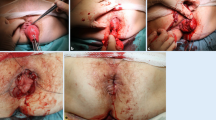Abstract
Background
Previous studies of the outcome after perineal stapled prolapse resection (PSPR) have included a limited number of patients with a short follow-up and high recurrence rates. The present study was designed to assess the initial results, complications, recurrence rate, and outcomes up to 4 years after PSPR, as well as the need for a repeated procedure.
Methods
Fifty-four consecutive patients with rectal prolapse (mean age 77.2 years, range 46–93 years; n = 3 men) were selected for PSPR between May 2009 and February 2015. Prolapse length was measured at baseline and after surgery. Patients were asked to grade intensity of symptoms as a satisfaction score of 1–10, 10 representing being symptom-free.
Results
The mean operation time was 45.3 min (SD = 17.5, range 25–95 min). The mean rectal prolapse length was reduced significantly from 9.5 cm (SD = 5.0, range 4–30 cm) to 1.2 cm (SD = 2.6, range 0–10 cm; p < 0.0001). Bleeding requiring surgical intervention occurred in two patients (3.7%). Postoperative satisfaction score increased from a mean of 2.2 (SD = 0.9) to a mean of 6.4 (SD = 2.8, p ≤ 0.0001). After a mean follow-up of 13.4 months (SD = 14.1), six patients with recurrence underwent a new PSPR and five patients underwent colostomy, mainly because of incontinence, resulting in a recurrence rate of 20.4%. There were no complications after redo PSPR, and after a median of 10-month follow-up (range 6–37), there were no recurrences.
Conclusions
PSPR is a rather new surgical procedure for external rectal prolapse. Immediate complications are few and not serious. Although recurrences can be treated with a second PSPR, the operation may only be the best option for old and fragile patients with comorbidities and a short life expectancy.



Similar content being viewed by others
References
Scherer R, Marti L, Hetzer F (2008) Perineal stapled prolapse resection: a new procedure for external rectal prolapse. Dis Colon Rectum 51:1727–1730
Romano G, Bianco F, Caggiano L (2009) Modified perineal stapled rectal resection with contour transtar for full thickness rectal prolapse. Colorectal Dis 11:878–881
Tschuor C, Limani P, Nocito A, Dindo D, Clavien PA, Hahnloser D (2013) Perineal stapled prolapse resection for external rectal prolapse: is it worthwhile in the long-term? Tech Coloproctol 17:537–540
Ram E, Krissi H, Zbar A, Atar E, Joubran S, Rath-wolfson L (2014) Perineal stapled prolapse resection (PSPR) in elderly patients for external rectal prolapse: early experience. Tech Coloproctol 18:1003–1007
Hetzer FH, Roushan AH, Wolf K et al (2010) Functional outcome after perineal stapled prolapse resection for external rectal prolapse. BMC Surg 10:9
Sehmer D, Marti L, Wolf K, Hetzer FH (2013) Midterm results after perineal stapled prolapse resection for external rectal prolapse. Dis Colon Rectum 56:91–96
Raahave D, Christensen E, Loud FB, Knudsen LL (2009) Correlation of bowel symptoms with colonic transit, length, and faecal load in functional faecal retention. Dan Med Bull 56:83–88
Raahave D, Loud FB, Christensen E, Knudsen LL (2010) Colectomy for refractory constipation. Scand J Gastroenterol 45:592–602
Kimmins MH, Evetts BK, Isler J, Billingham R (2001) The Altemeier repair: outpatient treatment of rectal prolapse. Dis Colon Rectum 44:565–570
Boccasanta P, Venturi M, Barbieri S, Roviario G (2006) Impact of new technologies on the clinical and functional outcome of Altemeier’s procedure: a randomized, controlled trial. Dis Colon Rectum 49:652–660
Cirocco WC (2010) The Altemeier procedure fore rectal prolapse: an operation for all ages. Dis Colon Rectum 53:1618–1623
Bruch HP, Herold A, Schidek T, Schwandner O (1999) Laparoscopic surgery for rectal prolapse and outlet obstruction. Dis Colon Rectum 42:1189–1194
Wilson J, Engledow A, Crosbie J, Arulampalam T, Motson R (2011) Laparoscopic nonresectional suture rectopexy in the management of full-thickness rectal prolapse: substantive retrospective series. Surg Endosc 25:1062–1064
Zittel TT, Manncke K, Haug S et al (2000) Functional results after laparoscopic rectopexy for rectal prolapse. J Gastrointest Surg 4:632–641
Boons P, Collinson R, Cunningham C, Lindsey I (2010) Laparoscopic ventral rectopexy for external rectal prolapse improves constipation and avoids de novo constipation. Colorectal Dis 12:526–532
van Geleuwe B, Wolthuis A, Penninckx F, D´Hoore A (2013) Lessons learned after more than 400 laparoscopic ventral rectopexies. Acta Chir Belg 113:103–106
Raahave D, Jepsen LV, Pedersen IK (2008) Primary and repeated stapled hemorrhoidopexy for prolapsing hemorrhoids: follow-up to five years. Dis Colon Rectum 51:334–341
Author information
Authors and Affiliations
Corresponding author
Ethics declarations
Conflict of interest
The authors declare that they have no conflict of interest.
Ethical approval
All procedures performed in the present study involving human participants were performed in accordance with the ethical standards of the institutional and/or national research committee and with the 1964 Helsinki Declaration and its later amendments or comparable ethical standards.
Informed consent
Informed consent was given orally.
Rights and permissions
About this article
Cite this article
Raahave, D., Jensen, A.K., Dammegaard, L. et al. Primary and repeated perineal stapled prolapse resection. Tech Coloproctol 20, 853–857 (2016). https://doi.org/10.1007/s10151-016-1557-9
Received:
Accepted:
Published:
Issue Date:
DOI: https://doi.org/10.1007/s10151-016-1557-9




